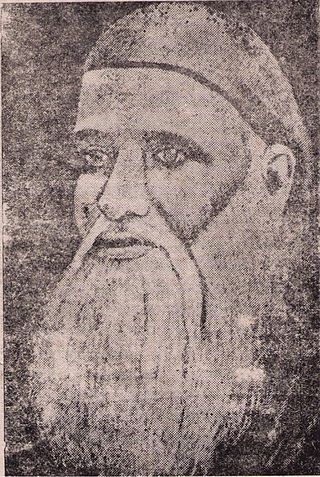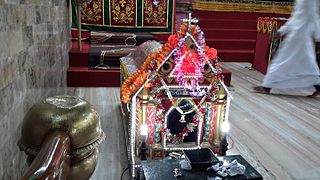
The Malankara Mar Thoma Syrian Church, often shortened to Mar Thoma Church, and known also as the Reformed Syrian Church and the Mar Thoma Syrian Church of Malabar, is an autonomous Oriental Protestant Christian church based in Kerala, India. While continuing many of the Syriac high church practices, the church is Protestant in its theology and doctrines. It employs a reformed variant of the West Syriac Rite Divine Liturgy of Saint James, translated to Malayalam.

Mathews Mar Athanasius (Mar Thoma XIII) (25 April 1818 – 16 July 1877) was the Malankara Metropolitan of the Malankara Church from 1852 until 1865. As a reformer, he spent most of his reign attempting to reform and heal rifts within the church. However in 1865, he was deposed by the traditionalist faction of the Malankara Church and Pulikkottil Joseph Dionysius became their leader.

Alexander Mar Thoma XIX Metropolitan was the Metropolitan of the Malankara Mar Thoma Syrian Church with its center in Kerala state in south-western India.

Joseph Mar Thoma XXI was the 21st Mar Thoma Syrian Church Metropolitan and the church’s primate.
Mar Thoma I, also known as Valiya Mar Thoma and Arkkadiyokkon Thoma in Malayalam and Thomas de Campo in Portuguese was the first native-born, popularly-selected Metropolitan bishop of the 17th-century Malankara Church. He was the last Archdeacon of the undivided St. Thomas Christians of Malankara (Maliyankara).
Mar Thoma II was the second Metropolitan of the Malankara Church from 1670 to 1686.
Mar Thoma V was the 5th Malankara Metropolitan from 1728 to 8 May 1765. He was born as Ousep to the Pakalomattom family, one of the oldest families in Kerala. His tenure faced numerous challenges and conflicts with bishops sent from the Syriac Orthodox Patriarchate in Antioch, resulting in some of these Syriac bishops being banished from the country and forced to return.

Palakunnathu Abraham Malpan, was an Indian cleric and theologian known for the Reformation movement within the Malankara Church during the 19th century. He was born in the ancient Syrian Christian Palakunnathu family which practiced West Syriac Rite Oriental Orthodoxy after the Coonan Cross Oath of 1653.

Abraham Mar Thoma XVII Metropolitan was the Metropolitan of the Malankara Mar Thoma Syrian Church from 1944–1947. He was called Maret Kochu Thirumeni by his people. Among the bishops of Malankara Churches Including Mar Thoma Church, Abraham Mar Thoma was the first to earn a Doctoral degree.

Titus II Mar Thoma Metropolitan (Mar Thoma XVI) (6 May 1866 – 6 July 1944) was the head of the Malankara Mar Thoma Syrian Church with its center in Kerala state in south-western India. He was known as Thithoos Dwitheeyan Mar Thoma Metropolitan among his people. (Thithoos is Aramaic and Malayalam)

Titus I Mar Thoma Metropolitan (Mar Thoma XV) (20 February 1843 – 20 October 1909) was known as Thithoos Mar Thoma Metropolitan (Thithoos is Aramaic and Malayalam) was the second Mar Thoma Metropolitan (1893–1909) after the Malankara Church split as the Orthodox and reformist factions.
Mar Dionysius I (Mar Thoma VI) (died 8 April 1808), was the 6th Metropolitan of the Malankara Syrian Church from 1765 until his death. A member of the Pakalomattom family (Thazhmon, Ayroor) he appealed to outside authorities to assert his position as the sole leader of the Malankara Church and to attempt to reunite all the Saint Thomas Christians.

Mar Thoma IX was the ninth Metropolitan of the Malankara Church in Kerala, India for a brief period in 1816. That year, he was consecrated Metropolitan by Mar Thoma VIII, but soon after his ordination he was dethroned by Pulikkottil Joseph who was appointed by the then British resident Colonel John Munroe.
Mar Thoma VIII was the 8th Metropolitan of the Malankara Church in Kerala, India from 1809 to 1816. He was a man of vision. It was during his time Malankara church opened the first formal educational institution, in Kerala. With the opening of Kottayam Suryani Seminary, modern education dawned in Kerala.
Mar Dionysius II, born Pulikkottil Joseph Ittoop was 10th Malankara Metropolitan for nine months until his death on 24 November 1816. He dethroned Mar Thoma IX and succeeded him by the favour of Col.John Munroe, then British Resident of Travancore. Despite the brevity of his reign he made lasting contributions to the Malankara Orthodox Syrian Church.
Mathews Mar Athenasius Episcopa was the first missionary bishop of the Mar Thoma Church. As a diocesan Episcopa he did remarkable pioneering work in organising parishes and new mission fields. His evangelical ardour and concern for the unreached area, made him forge ahead expansion programmes and colonisation schemes besides establishing of several institutions.
Mar Thoma IV was the 4th Malankara Metropolitan of the Malankara Church in India, serving from 1688–1728. During his tenure, the church was subject to a number of persecutions.
St. Mary's Orthodox Cathedral, Puthencavu is one of the important churches in South India, located at a village named Puthencavu, Alappuzha district in Kerala state of India. The church is one of the oldest Christian churches in the Central Travancore region of Kerala.

Mar Thoma Metropolitan, is the title which is given to the Supreme Head of the Malankara Mar Thoma Syrian Church. The Malankara Church was split into different factions over the years. However the Supreme Head of the Malankara Mar Thoma Syrian Church uses the title of Mar Thoma Metropolitan upholding the autonomous character of the Malankara Mar Thoma Church. The Current Mar Thoma Metropolitan of The Holy Apostolic Throne of St Thomas is Dr Theodosius Mar Thoma









